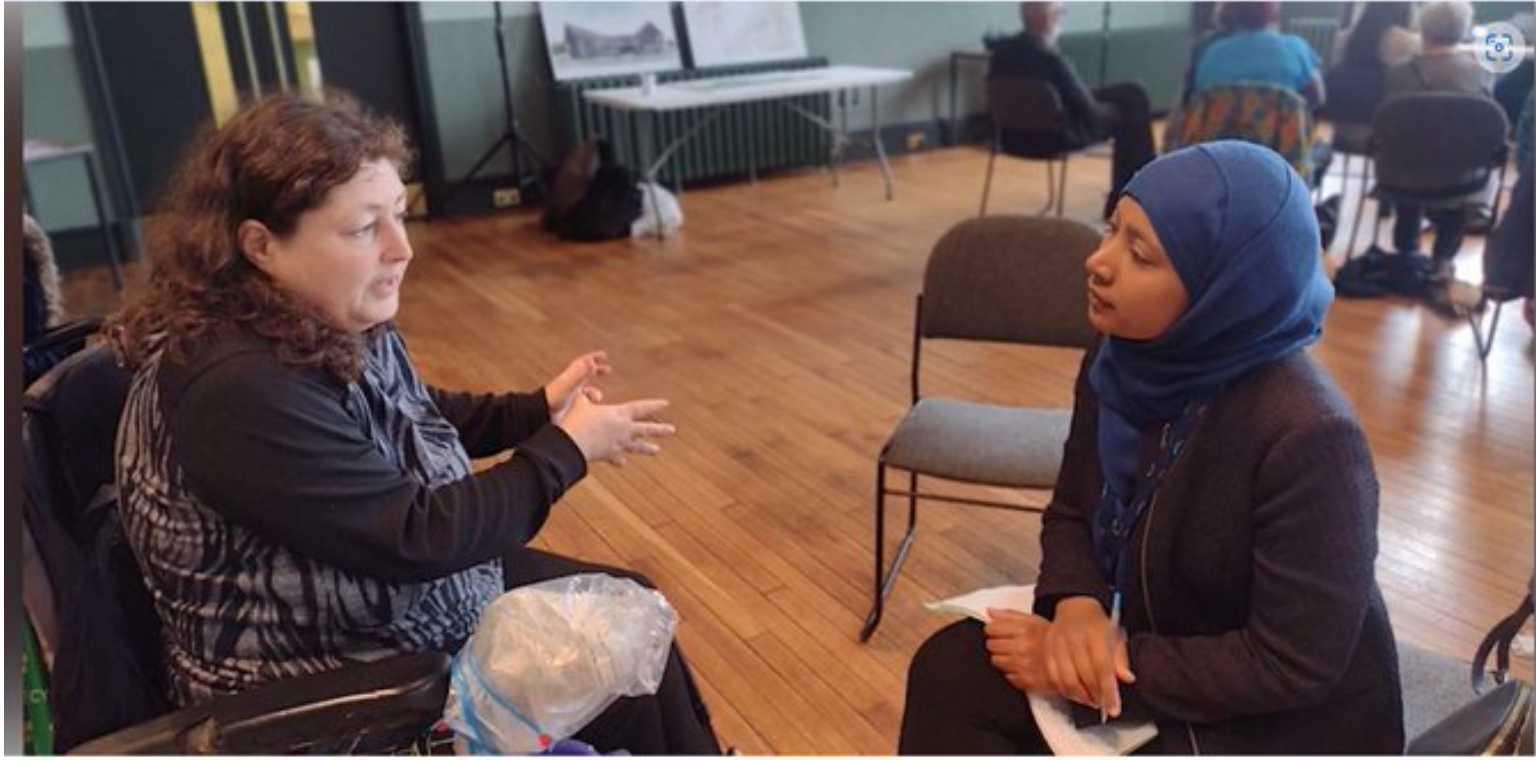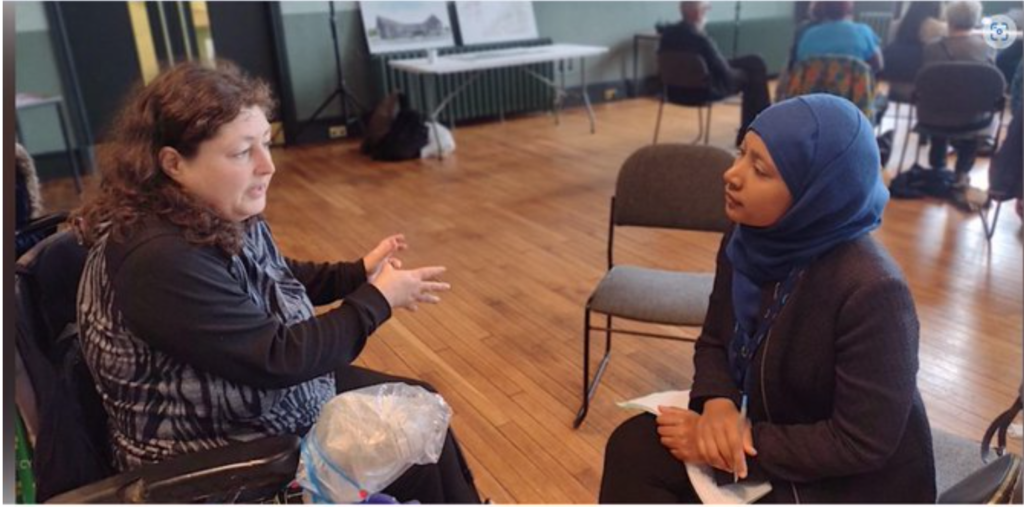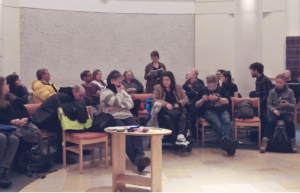By Gareth Fearn
When you mention ‘the planning system’ to most people in the UK they will probably either roll their eyes or have no idea what you are talking about. Even for many of those interested and active in some form of leftist politics, the planning system itself tends to not be a particular object of concern even if the struggles that it often mediates are. And whilst these struggles, over housing, energy, environment, public space etc are continually renewed, planning system itself becomes an object of contestation in more sporadic political moments.
We face such a moment today. The neoliberal wings of the Conservatives and Labour and their friends in the press are attempting to drive forward land-use planning liberalisation despite their being little public demand for them to do so. The Tories have seen their planning reforms thwarted by their base, with Labour now promising to take up the baton of further liberalising planning in the name of creating economic growth and tackling the energy and housing crises.
The contestation over the planning system is one that could have long term impacts on political struggles and the perpetual crises we will face in the coming decades. It is imperative that progressives resist the neoliberal drive to reduce the democratic aspects of planning and its reform towards a merely technocratic system for capital accumulation. Decisions over land use are ones over the very basics of life, where we live, where we spend our time, even what we eat. Here, I briefly set out the historic and present political contestations over planning and why it is of important for progressives to fight for a democratic, public planning system.
From Enclosure to the 1947 Act
The origins of land use planning, as distinct from economic planning, is the privatisation of land by the emergent modern capitalist-colonial state. Britian was one of the first movers in this process, through a system of ‘enclosure’ which was co-developed domestically and colonially. Through the medieval period, more and more common land was enclosed by landlords but through the American and Caribbean plantations techniques of surveying and planning were developed which would then be utilised domestically. The wealth created from chattel slavery which flowed from these colonies was invested in land by not only the existing landowners but the new merchant class, and the system of parliamentary enclosure (from 1774) formally set out a process of surveying, consultation and spatial planning to create nearly full privatisation of land by the end of the 19th century. Land privatisation, and these early planning practices, were extended to and co-developed with British colonial territories.
In Britain, this system of land privatisation was driven by the desire to improve the efficiency of the primarily agrarian economy. By the 19th century though, enclosure and privatised land intersected with industrial capitalism: creating a workforce with nothing to sell but their labour as well as opportunities for slum landlords to profit from workers meagre wages. As the century wore on, it became clear that the power private property did not have the utopian characteristics envisaged by its classical liberal advocates, and that individual property owners would not magically act in the general interest. Thus, something more like the modern planning system was developed piecemeal – with liberal social reformers like the Fabians arguing for greater public intervention to reduce disease and improve housing conditions – i.e. for the state to act to ensure social reproduction. Disease control and eugenics also supported the logic of colonial planning practices, creating new avenues for accumulation by dispossession.
After the Second World War though, land-use planning was reformed in a more social-democratic direction at the height of the power of the labour movement. The Town and Country Planning Act in 1947 built on the piecemeal reforms on housing and public health, but instituted a more general public planning system – with local authorities more like those we have today (rather than 1000s of parishes etc) in charge of planning and shaping development and managing the growth of cities. The Act effectively nationalised the right to develop and use land, making planning policy subject to the decisions of elected Members of Parliament and the new local authorities.
The Act, along with the creation of National Parks in 1949, responded to workers demands for better housing and reclaiming land from the aristocracy and capitalist class – a counter movement to the system of enclosure. The Act marked a significant democratisation of land, but as with other aspects of the welfare state this brought with it an expanded technocratic, public profession of planning – who would lead the modernist urban development boom.
The Act also set out the basis for conservation and heritage protection, with the introduction of listed buildings selected for preservation and restoration after the second world war and the categories of heritage protection have expanded since. It made provision for local authorities to include a ‘green belt’ to limit urban expansion, something which subsequent governments further encouraged and expanded.
The new planning profession shaped the cities and infrastructure we know today, empowered by significant state investment particularly in public housing. By the 1970s though, critics from the left and right argues that the planning system was too top down and bureaucratic, with conservatives criticising what they saw as the weakness of heritage and conservation protections and the progressives arguing for more public participation in planning. There was also a further critique, from both left and right, that planning had become an impediment to economic growth amidst the crises of the 1970’s and global economic restructuring which followed.
Planning and Neoliberalism
As many authors have set out, the neoliberal critique of the crises of the 70s would become the dominant diagnosis and set of policy prescriptions for how to reboot capitalism. The idealogues of neoliberalism detest public planning practices and democracy. For the likes of Hayek and Thatcher, attempts to shape and replace markets with strong regulation or public ownership distort the price mechanism and created inefficiency and for them this was the root of the crisis. As part of a class project to wrestle back the gains made by labour and anti-colonial movements, neoliberals across the world argued for a strong state to create and manage markets through privatisation and the rule of law. Democracy, insofar as it was a means by which people challenged and rejected the market order, was by-passed and over-ruled with explicit violence, coercion and depoliticization as means of shifting the balance of power back towards capital from labour.
Within British land-use planning, it is the democratisation of land-use decisions in the 1947 Act which neoliberals abhor and which is seen as greatest impediment to capitalist growth. The principle of the Act is that it allows people to make decisions outside of a market rationality, politics to intervene in economics. Since the Thatcher government, the repeal of the Act and removal of democracy from planning has been a recurring priority. As well as privatising significant amounts of UK housing stock through ‘right to buy’, the Thatcher government attempted to more fully liberalise planning in 1986, only to be thwarted by those in the Tory base who enjoy the local powers to block developments near their rural villages and the protection of the ‘green belt’. What her government did successfully introduce though, were the use of special ‘zones’ where the planning process is effectively suspended – this was the model for the development of Canary Wharf for example – and overseen by ‘development corporations’ led by the private sector. These zones were derived from colonial planning practices, and were also advocated in a different form by the more Fabian tendencies of the New Left. The zones and Urban Development Corporations tended to produce heavily privatised and policed spaces, tailored to the needs of capital, and continue today in the governments Freeport experiment – with the Teesside example now mired in allegations of corruption and environmental damage.
New Labour were arguably more successful in integrating the private sector into planning, but they did so alongside promoting forms of public participation and strategic planning. They implemented practices of ‘stakeholder engagement’ which more subtly excluded dissent to development – whilst simultaneously reshaping the planning profession through audits, targeting and the increased use of private sector consultants. That said, they did at least fund local authorities (albeit through PFIs!) and attempt to reshape de-industrialised cities with some consideration of local needs, but they did so whilst overseeing a real estate bubble, the emergence of the buy-to-let landlord class and continuing the Thatcherite rejection of social housing. The strategic planning programme was severely undermined by the public rejection of regional governments in the North East referendum, as this meant that regional planning was disconnected from representative government.
The austerity imposed by the Coalition government created the space to drive through further neoliberal reform to planning. Whilst they failed to fully repeal the 1947 act, the Localism Act 2011 managed to significantly reduce the amount of planning policy and guidance in England, and this combined with around 50% funding cuts to planning departments has created a confusing situation in which planning decisions are open to significant delay and ambiguity whilst also creating a free-for-all of development in areas where land values are higher as local government begs capital for investment (in London, Manchester etc). Planning departments have ben hollowed out, with private sector consultants increasingly taking on the public duties of plan-making, policy and development management.
As readers are likely aware, most major cities in the UK are now playgrounds of property speculation, with generic new build apartments popping up every few weeks which charge rents out of reach of more than half of the population. Thus, despite the various liberalising moves of the last decade, a housing crisis persists as rent and prices continually outstrip stagnant wages. The housing crisis, as well as the energy crisis, have led to a political moment for planning reform.
Never let a crisis go to waste
With the UK facing a housing and environmental (of energy as well as pollution) crisis, planning reform is once again on the agenda. The neoliberal wing of the Conservatives, their decrepit (invisible) hands clinging to the holy grail of liberalised planning, tried to use the pandemic as an opportunity to drive forward the same old planning reforms once more. The reforms were basically lifted from a Policy Exchange paper (along with its authors), to form the blueprint for the Planning for the Future white paper. The report argued that the capitalism has come to favour “insiders over outsiders”, though notably the ‘insiders’ are not those with actual power (capital, media, politicians) but instead those with more marginal influence such as those on ‘tenured contracts’ and those whose house prices increase through ‘land use restrictions’.
The Policy Exchange report and white paper target the highly discretionary nature of UK planning which comes from the 1947 Act. Despite planning systems which are more zonal, like those in the US, also facing a significant housing crisis; the focus for neoliberal reform in the white paper was to shift England towards a three-zone system. The proposed system would have had centrally defined rules and regulations, replacing the discretionary system entirely and increasing the use of algorithms and ‘PropTech’. Public participation and local democracy are cast as barriers to market efficiency, as they apparently facilitate a ‘noisy minority’ thwarting the will of the silent majority. The white paper looked to formalise trends we have seen in planning over the last decade: de-regulation through ‘permitted development’, greater executive powers for ministers, streamlined policy (which creates ambiguity).
The legislation based on the white paper was though, thwarted by a rebellion of the wealthy homeowners in Tory majority seats. The planning reforms were a central issue in the dramatic by-election loss in Chesham and Amersham, and eventually the government ditched the proposals and even went as far as giving up on housing targets entirely. What is left of planning reform has been shoe-horned into the Levelling Up and Regeneration Bill, the main focus of which is deepening the trend of giving more ad-hoc decision-making powers to ministers in the absence of a public planning system which has been stripped to the bone through austerity.
NIMBYS, YIMBYS and the Magical Market
The neoliberal thinktanks and lobbyists appear to have realised the Tories are a busted flush, and have smartly re-oriented their proposals on planning reform towards Labour. A new group called Britain Remade, seemingly set up entirely for this purpose by one of Boris Johnson’s former advisors and a former Adam Smith Institute wonk, have lobbied Labour on planning liberalisation from a green energy perspective – encapsulated in their first major report launch being held at the HQ of a major energy company with Ed Miliband giving an opening speech. Rumour has it that planning policy is now being significantly overseen by Rachel Reeves’ and the Leaders office, with her and Starmer continually repeating the slogan ‘Builders not the Blockers’ to exemplify their stance on planning reform – where the ‘blockers’ are the middle class homeowners who challenge new developments – i.e. the NIMBYs. It remains to be seen whether the change from Nandy to Raynor as the Secretary of State will yield any significant challenge to this policy.
The proponents of neoliberal planning reform in both parties, thinktanks and the astroturf campaigns of ‘YIMBYs’ tell a particularly ideological tale to legitimate further liberalisation as the solution to the crises caused by liberalisation. The story goes, that despite the best efforts of the valiant neoliberal crusaders, the discretionary structure of planning in the UK means that wealthy homeowners are able to reject not just new housing sites but also infrastructure too – slowing down or stopping development. What we apparently get a planning system which supports the ‘noise minority’ of ‘NIMBYs’ to whom local and national government is too permissive. The ‘NIMBYs’ tend to be local councillors or residents opposed to a development, but in practice this can stretch to just about anyone who has reservations or critiques of development however well founded their view might be. If you aren’t blindly cheerleading for capital, chances are you are a NIMBY.
The growth of the housing crisis globally has led to a resurgence in accusations of NIMBYism as well as the growth of so-called YIMBY movements as a means of creating support for further deregulation and neoliberal urban development patterns. YIMBY’s, who in the US at least receive significant financial backing from capital, target local/state politicians as the blockages to housing growth and attempt to show support for just about any new development proposed. In California, what we have seen in practice is well-funded tech-workers supporting and campaigning for planning and housing de-regulation and particular developments even if they threaten to displace existing communities. The ‘YIMBYs’ have thus found themselves in direct conflict with working class, Black and Latinx activists who have been campaigning on housing issues for decades – with the latter demanding more public and affordable housing rather than entertaining the absurd fantast that any new housing will increase affordability.
This is not to say that so-called NIMBY’s do not exist in the UK, just that their power is exaggerated. Clearly there are examples of middle-class homeowners limiting urban expansion particularly in the south east of England to protect their asset values. The ideological sleight of hand is to foreground the marginal power of the ‘NIMBY’, instead of the hegemonic power of landowners, developers, and finance capital – each of whom are vastly more influential on the housing and environmental crises and land use decisions. The ‘NIMBY’s’ (if we take this to mean homeowners on London’s periphery) can and do thwart further neoliberal reforms, but they are not the reason why housing is increasingly unaffordable or why we are facing delays in developing the national grid and renewable energy. Their power is not in acting as blockage to particular developments, it is in being important enough to the governemnt to limit the replacement of politics with the market in an area which would damage their particular interests.
Attacks on the planning system, which is portrayed as blocking economic activity by being too easy to game by the NIMBYs, are instead a form of disavowal: it is easy and comforting to pretend that we just need to liberalise planning a bit more rather than actually address the profound structural crises of neoliberalism e.g. stagnating wages, corporate profit drive inflation, economic and political inequality. The core of this structural crisis is that, for decades, the failure to invest in the social reproductive activity and infrastructures which sustain our lives – with investment instead seeking the high returns offered by financial products and (importantly for this article) real estate speculation. Put simply: no one has been forcing the rich to give their money to the things we actually need.
The reality is that the root of both energy and housing crises is a lack of public investment and co-ordination, with provision of both privatised in order to facilitate tax cuts and upwards distribution of wealth as well as granting significant power to real estate and fossil capital. This is why the discretionary planning system was able to deliver home-building and infrastructure in the immediate post-war period: it did so in tandem with the state-led provision of these public goods. Low taxes and privatisation have discouraged the investment in the infrastructure the capitalist economy (and all human life) requires. The mythology of Thatcherism is that the market would take up the space vacated by public bodies and ownership, but we now live in a world where the continuation of this myth and the consequences of adhering to it can only be delivered through authoritarian forms of government.
Labour’s indulgence of the YIMBY-thinktank fantasy, of the ‘blockers’ vs the ‘builders’, may simply be a cheap electoral shot on an issue that divides the Tories. Importantly, Labour do seem to want to invest in green energy and even potentially in social housing – and these are the actions that will actually make a difference if they follow through with them. The problem they will find is that, in order to invest effectively, they will likely need a strong public planning system as I and colleagues have argued for here. Further, the housing crisis is now so severe it will likely need more than just investment into social housing – such as rent controls, greater public involvement in housing development even by the private sector, and clear regulations on housing standards to ensure climate adaptation. Indulging the neoliberal fantasy of YIMBYism may help Labour produce some snappy slogans, but if they want to change the lives of workers than they will need to focus much more on how we invest in and plan for housing and energy rather than following the market fantasy that simply adding units will bring down prices.
More fundamentally, the focus on planning liberalisation is one that misdiagnoses a material problem as a political one. For those who want to perpetuate inequality and the power of capital over workers, this is a deliberate act. But for those who claim to represent the interest of labour, the misdiagnosis means indulging in reforms to a system to solve problems outside of the scope of that system alone. The over-investment in speculative finance capital and real estate, the over-accumulation of wealth in the growing billionaire class who seek safe harbour in real estate, these are global political-economic issues which drive housing and energy crises which will continue until a significant counter-hegemonic force shifts the balance of power domestically and internationally. We are at a moment where states are ramping up investment into energy in particular, the question is who will gain the most from this renewed investment.
Planning liberalisation is one means of ensuring that capital and some sections of the middle class take the lions share. Indeed, we could view the NIMBY/YIMBY divide as one between the established middle class and the more precarious professional class – what Dan Evans terms the ‘new petty bourgeoisie’. As in the US, the YIMBY-thinktank gambit is that enough of the new petty bourgeoisie can be won over to the idea that deregulation and planning liberalisation will deliver them a chance to get on the property ladder, rather than doing anything crazy like taxing wealth or property. If these more neoliberal reforms are pursued by Labour in office they will most likely be a disaster for working class communities, as well as the political legitimacy of major energy projects if they are simply forced through without wider public debate. The push for planning liberalisation is a call to perpetuate a failed system, rather than to do the difficult political work of redistributing wealth and investing in the state’s capacity to make democratic and effective decisions on major projects itself rather than the present consultant driven model which produces reams of pointless bureaucracy.
Instead, we ought to be looking to extend the democratic aspects of land-use and strategic planning. The figure of the Oxfordshire homeowner makes an easy bogeyman as a ‘NIMBY’, but this helps to obscure the many struggles fought out in planning which would be considered more worthy and useful by the wider public. Shale gas fracking, the Haringey Development Vehicle, the Latin Village, the Trees not Cars campaign in Manchester, battles over airport and road expansions: all examples of where community and activist groups have contested decisions and plans which have detrimental ecological and social impacts governments and industry were all too willing to brush under the carpet. The planning system needs significant reform, but reform which empowers a public planning system with clear policy, resources and the capacity to make plans which can lead private development for the housing and infrastructure we need.
The socialist and progressive position is to argue for something more universal, not simply more homes in the shires for those who’ve made it through the London rat race but good quality housing as a right for all, the end of landlordism and the fundamental principle that the people get to decide how land is used, not the speculators and rentiers. Further planning liberalisation won’t resolve the housing and energy crises because these are crises resulting from decades of neoliberalism and austerity and which will require significant state renewal to address – not the cheap and dangerous shortcut of liberalisation. The 1947 Act was introduced to address the devastation wrought by the lack of democratic control over land use, and whilst it is imperfect, we ought to defend its basic principle that the people get to decide how land is used. The land is ours, after all.
This article was made possible thanks to the generous support of the Lipman-Miliband Trust.

















